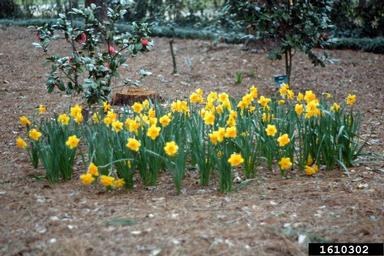Daffodils are associated with the beginning of spring.

John Ruter, University of Georg
The daffodil is sometimes called daffadowndilly, narcissus, or jonquil. However, daffodil is the correct common name according to the American Daffodil Society. Narcissus is the botanical name of the genus for the daffodil (Narcissus spp.), in the family Amaryllidaceae. Jonquil refers to a specific kind of daffodil.
The botanical name is derived from the Greek mythological character Narcissus, who loved himself greatly and became obsessed with his own beauty. Tragically, his extreme self-admiration ultimately led to his demise. After seeing his reflection in a river, he went to stare more closely at himself, fell into the water, and ultimately drowned. Because of this tale, daffodils have sometimes been considered a symbol of vanity. However, daffodils have a long history, holding many different meanings and interpretations.
Native to Europe, North Africa, Western Asia, and the Mediterranean region, daffodils were grown by the ancient Greeks. The decorative use of daffodils can be found in ancient Egyptian tombs and frescoes at Pompeii. The Romans, who thought that the sap of the daffodil had healing powers, eventually brought them to Britain.
The daffodil is the national flower of Wales. It represents faithfulness due to its ability to re-bloom at the same time every year. In China, daffodils symbolize good luck and prosperity because they bloom around the time of the Chinese New Year. According to Chinese tradition, if daffodils bloom exactly on New Year's Day, you will have good luck for the entire year. In the United States, the American Cancer Society uses the daffodil to represent hope for a cure. Daffodils symbolize new beginnings because they are the first spring flowers to bloom after winter. They can also represent creativity, kindness, ambition, beauty, and inspiration and often make appearances in art and classical literature.
The daffodil has been associated historically with death and rebirth--from the death of the self-loving Narcissus in Greek mythology to its perennial return as an uplifting spring flower.
Today, the daffodil is the most widely grown in Holland and Great Britain with over 13,000 hybrids ranging from yellow and white, to mixtures of orange and pink. They are one of the oldest cultivated bulbous ornamental plants.
According to Dr. Leonard Perry, Extension Professor at the University of Vermont,
Daffodils are a huge group, with about a dozen different classifications, depending on height and type of flowers. Flowers consist of outer petals (together called the "perianth"), and usually inner ones fused into a tube (called the "corona"). If the corona is equal to or longer than the petals, it is called a "trumpet." If it is shorter, it is called a "cup." … Then there are the more exotic types such as the butterfly and double daffodils. Butterfly types are those with the corona split and perhaps ruffled in appearance… Double daffodils have double petals, double corona, or both.
Plant daffodils in the fall for blooms the following spring. Daffodils need about 4 to 6 weeks of warm soil temperatures to establish roots before the winter freeze. In Northeast Pennsylvania, the best time to plant is late September through October. Depending on the size of the bulb, plant so that the bulb base is about 5 to 6 inches below the soil surface. Always follow planting directions on the packaging. Press bulbs into the soil with the pointed end up and the root base down. Cover with soil and mulch, if feasible. The mulch will help insulate the soil, keeping it warmer for the bulbs to have a longer time to establish roots. Mulch also helps to keep down weeds.
Daffodils lend themselves to informal plantings as well as formal gardens. They look nice and do well planted in irregular clumps throughout a landscape. Individual plantings, randomly spaced are achieved by deciding where you would like to see the daffodils and simply just tossing out a handful of bulbs in a garden area. Where they land is where you dig planting holes. (Ideal spacing is 6 to 12 inches apart.) Digging may be done easily with a bulb planting tool--a wide tapered metal tube on a handle that scoops out soil, leaving a hole for the bulb. This method can be done in your lawn as well. The blooms will fade before the lawn needs to be mowed.
Daffodils can be grown in almost any well-drained area. While they grow and bloom best in direct sun, they will tolerate part shade (about 4 to 6 hours of direct sun). Daffodils require some cold in order to bloom. To "force" daffodils into early blooming, pot bulbs in the fall with bulb tips level with, or just above, the rim of a container. Keep moist and cool (ideally 40-45° F) for 12 to 16 weeks. Do not allow the bulbs to freeze. After this time has elapsed, remove them from their cold storage and water well as growth starts. Leaves appear fairly soon, with blooms following in 3 to 4 weeks.
Planting daffodils is an investment that pays dividends of bright color in early spring. Daffodils multiply easily with minimal care and deer and other mammals avoid them. Plant some daffodils and watch the explosion of color come early spring!
~by Joan Banyas, Luzerne County Master Gardener Trainee

